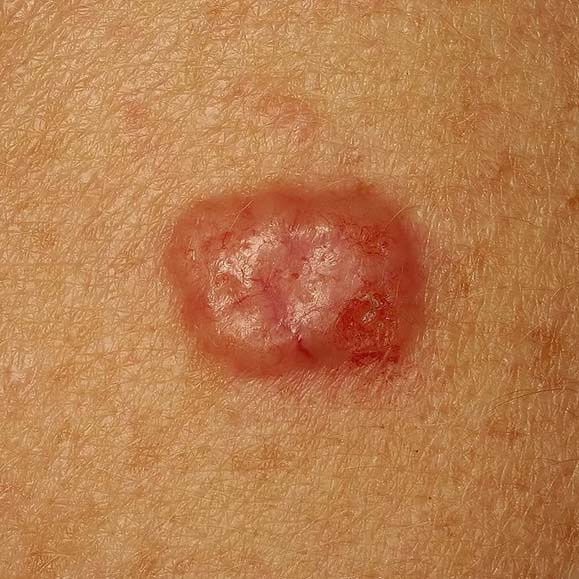Basal Cell Carcinoma
Home • Dermatology • Skin Cancer, Pre-Cancerous Lesions & Treatment • Basal Cell CarcinomaCauses
Basal cell carcinoma (BCC) is the most common type of skin cancer, affecting millions of individuals worldwide each year. It originates in the basal cells, which reside in the lowest layer of the epidermis and are responsible for producing new skin cells. While BCC is rarely life-threatening, it can cause significant disfigurement if left untreated and has the potential to invade surrounding tissue.
The primary cause of BCC is ultraviolet (UV) radiation exposure, which damages the DNA in skin cells. This damage leads to mutations that cause basal cells to grow uncontrollably. The UV radiation can come from natural sunlight or artificial sources, such as tanning beds.
Other contributing factors include:
- Chronic Sun Exposure: Frequent exposure to sunlight, especially in childhood or during outdoor occupations, increases the risk.
- Tanning Beds: The use of tanning beds significantly elevates the risk, especially in young adults.
- Genetics: Conditions like Gorlin Syndrome (Basal Cell Nevus Syndrome) predispose individuals to multiple BCCs at an early age.
- Radiation Therapy: Previous radiation treatments may increase the risk of developing BCC.
- Chemical Exposure: Contact with arsenic and other carcinogenic chemicals may also raise the risk.
Risk
Although anyone can develop BCC, certain groups are at higher risk:
- People with Fair Skin: Individuals with light skin, blond or red hair, and blue or green eyes are at a higher risk, though it can affect people of all skin tones.
- Age: BCC is more common in older individuals due to cumulative sun damage over the years.
- Gender: Historically, men have been more likely to develop BCC, though rates among women are rising, likely due to tanning bed use.
- Immune-Compromised Individuals: Organ transplant recipients and people with immune-suppressive conditions are more susceptible.
- Geographic Location: Living in areas with high UV exposure, such as near the equator or at higher altitudes, increases the risk.
Symptoms
BCC often appears on sun-exposed areas such as the face, ears, neck, scalp, shoulders, and back. Common presentations include:
1. Open Sores: Persistent sores that bleed, ooze, crust, or fail to heal.
2. Shiny Bumps: Pearly or translucent lesions that may appear pink, red, or white. In darker skin tones, these can be brown, black, or tan.
3. Reddish Patches: Flat or slightly raised areas that may itch or feel tender.
4. Pink Growths: Lesions with rolled edges and a central depression, often with visible blood vessels.
5. Scar-Like Lesions: Areas of skin that appear shiny, white, or waxy with undefined borders. These can signify more invasive forms of BCC.
It’s important to note that these lesions may grow slowly over time, making early detection vital.
Diagnosis
Dermatologists use the following methods to diagnose BCC:
- Visual Examination: Initial assessment of the lesion based on appearance.
- Dermatoscopy: A specialized tool that magnifies and illuminates the skin for closer inspection.
- Biopsy: A small portion of the lesion is removed and examined under a microscope to confirm the diagnosis.
Treatment
Early detection of BCC leads to highly successful treatment outcomes. The choice of treatment depends on the tumor’s size, depth, location, and type.
-
- Surgical Treatments
- Excisional Surgery: The cancerous lesion is removed along with a margin of healthy tissue.
- Mohs Surgery: A precise technique that removes the tumor layer by layer, ensuring minimal tissue loss. It is highly effective for BCCs on cosmetically sensitive areas like the face.
- Curettage and Electrodessication: The lesion is scraped off, and the area is treated with an electric needle to destroy any remaining cancer cells.
- Surgical Treatments
-
- Non-Surgical Treatments
- Topical Medications:
- Imiquimod and 5-Fluorouracil (5-FU) are creams used for superficial BCCs.
- Photodynamic Therapy (PDT):
- Combines light exposure with photosensitizing drugs to kill cancer cells.
- Radiation Therapy:
- For patients who cannot or do not want to have surgery or for BCCs in hard-to-treat areas.
- Topical Medications:
- Non-Surgical Treatments
- Advanced TreatmentsFor rare cases of advanced or metastatic BCC, systemic therapies are available:
- Targeted Therapy: Drugs like vismodegib and sonidegib block the molecular pathways that drive cancer growth.
- Immunotherapy: Emerging therapies that harness the immune system to fight cancer.
Prevention
While BCC is highly treatable, prevention is always the best approach. Steps to reduce your risk include:
- Sun Safety Practices:
- Wear broad-spectrum sunscreen with an SPF of 30 or higher daily.
- Seek shade during peak sun hours (10 a.m. to 4 p.m.).
- Wear sun-protective clothing, wide-brimmed hats, and UV-blocking sunglasses.
- Avoid Tanning Beds:
- The use of indoor tanning devices dramatically increases the risk of skin cancer.
- Regular Skin Examinations:
- Perform monthly self-examinations for new or changing lesions.
- Schedule annual check-ups with a dermatologist.
Prognosis and Importance of Early Detection
BCC is rarely life-threatening and has an excellent prognosis when treated promptly. Untreated cases, however, can invade deeper tissues, causing significant damage to nerves, muscles, and even bone. Regular dermatological screenings and patient awareness play a critical role in early detection and successful treatment.
This detailed understanding of basal cell carcinoma highlights the importance of protecting your skin, recognizing warning signs, and seeking professional care for suspicious lesions. Early intervention ensures better outcomes and helps preserve your skin’s health and appearance.
